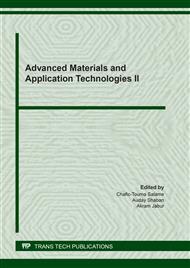[1]
CY. Chang, WR. Chen, Influence of processing variables on quality of unsaturated polester/E glass fiber composites manufactured by double-bag progressive compression method, Adv Mech Eng10 (2018) 1–9.
DOI: 10.1177/1687814018798531
Google Scholar
[2]
E. Ruiz, LR. Briones, É. Allard, F. Trochu, Flexible injection: a novel LCM technology for low cost manufacturing of high performance composites. Part I: experimental investigation, In: Proceedings FPCM9 (2008) p.34.
Google Scholar
[3]
K. Potter, Resin Transfer Moulding, Chapman & Hall, London (1997).
Google Scholar
[4]
J. Merotte, P. Simacek, SG. Advani, Resin flow analysis with fiber preform deformation in through thickness direction during compression resin transfer molding, Composites Part A41 (2010) 881–887.
DOI: 10.1016/j.compositesa.2010.03.001
Google Scholar
[5]
F. Rubino, P. Carlone, A semi-analytical model to predict infusion time and reinforced thickness in VARTM and SCRIMP processes, Polymers (2019), 11, 20.
DOI: 10.3390/polym11010020
Google Scholar
[6]
E. M. Sozer, Manufacturing techniques for polymer matrix composites (PMCs), Woodhead Publishing Limited, Cambridge, (2012).
Google Scholar
[7]
JM. Bayldon, IM. Daniel, Flow modeling of the VARTM process including progressive saturation effects, Compos Part A – Appl Sci Manuf40(8) (2009) 1044–52.
DOI: 10.1016/j.compositesa.2009.04.008
Google Scholar
[8]
A. Mamoune, A. Saouab, T. Ouahbi, Simple models and optimization of compression resin transfer molding process, Journal of Reinforced Plastics & Composites30 (2011) 1629-1648.
DOI: 10.1177/0731684411421539
Google Scholar
[9]
A. Hindersmann, Confusion about infusion: An overview of infusion processes, Compos Part A: Appl Sci Manuf (2019) 126.
DOI: 10.1016/j.compositesa.2019.105583
Google Scholar
[10]
J. Summerscales, TJ. Searle, Low-pressure (vacuum infusion) techniques for moulding large composite structures, Proc Inst Mech Eng, Part L: J Mater: Des Appl 219(1) (2005) 45–58.
DOI: 10.1243/146442005x10238
Google Scholar
[11]
S. Bickerton, MJ. Buntain, Modeling forces generated within rigid liquid composite molding tools. Part B: Numerical analysis, Composites: Part A38 (2007) 1742–54.
DOI: 10.1016/j.compositesa.2006.11.001
Google Scholar
[12]
NC. Correia, F. Robitaille, AC. Long, CD. Rudd, P. Simacek, SG. Advani, Analysis of the vacuum infusion molding process: I. Analytical formulation, Compos Part A: Appl Sci Manufact26 (2005) 1645–56.
DOI: 10.1016/j.compositesa.2005.03.019
Google Scholar
[13]
KV. Terzaghi, General stress conditions for the failure of saturated concrete and rock, Proceedings, American Society for Testing and Materials45 (1945) 777–801.
Google Scholar
[14]
F. Robitaille, R. Gauvin, Compaction of textile reinforcements for composites manufacturing. I: Review of experimental results, Polym Compos19 (1998) 198–216.
DOI: 10.1002/pc.10091
Google Scholar
[15]
P. Carman, Fluid flow through granular beds, Trans Inst Chem Eng15 (1937) 150–66.
Google Scholar


